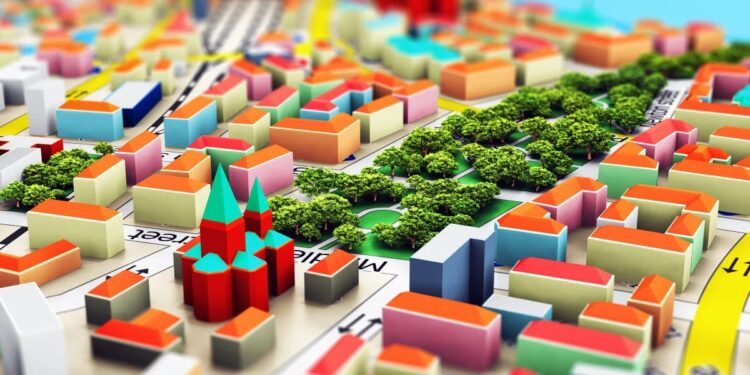Cities don’t just happen by chance – they are carefully planned. From the layout of streets and neighbourhoods to the placement of schools, parks, and essential services, urban planning is what shapes the spaces where we live, work, and socialise. As cities grow and evolve, the need for thoughtful, strategic planning becomes increasingly important. Urban planning brings together multiple disciplines to manage growth, guide development, and ensure that urban environments remain functional, inclusive, and sustainable. This article explores the key types of urban planning that help cities take shape. It also explains each the distinct role they each play in how urban areas are organised, experienced, and sustained.
What is urban planning?
Urban planning aims to optimise land use, infrastructure, transportation, and service availability within a town or city. Its goal is to enhance urban environments, support economic development, and promote sustainable growth. Urban planners are the people who help shape our city landscapes. They take on many important responsibilities including:
- City planning: They look at the future potential of cities, considering factors like population growth, economic development, and environmental sustainability.
- City layouts: They focus on the physical layout of cities, from land use and zoning, to transportation systems and public spaces.
- Strategy: They create long-term strategies that help guide urban development, ensuring that cities continue to meet local community needs.
- Future development: They plan for future challenges like housing affordability, transportation needs, service availability, and climate change.
What are the main types of urban planning?
There are many different types of urban planning. These include land-use planning, infrastructure planning, transportation planning, environmental planning, and landscape planning. Let’s go through each of them in more detail.
Land-Use Planning
Land-use planning is a core component of urban planning. It helps determine the best way to use local land – whether that’s for residential, commercial, industrial, recreational, or environmental purposes. In theory, land-use planning is highly strategic. It ensures that land is allocated in a way that supports growing communities, encourages economic development, and protects natural resources. In practice, land-use planning is also highly technical. It involves using things like zoning, planning controls, and planning policies to guide decisions about how land should be developed. As such, land-use planning focuses on structured, sustainable urban growth.
Infrastructure Planning
Infrastructure planning focuses on designing, organising, and managing the essential systems that support our everyday life. This includes things like local utilities (such as water, electricity, and sewage), communication networks (such as the internet), and public services (such as hospitals, libraries, and schools). Infrastructure planning ensures these systems are efficient, sustainable, and capable of meeting the needs of a growing population. It also helps protect cities against potential future challenges, related to climate change or resource shortages. As such, infrastructure planning focuses on optimising resources, minimising costs, and promoting sustainability.
Transportation Planning
Transportation planning is a key aspect of urban planning. It involves planning road networks and public transit systems (such as buses, subways, trams), as well as cycling infrastructure and pedestrian pathways. Transport planning takes into account factors like land use and infrastructure – to ensure that the city connects people to key services. It also takes into account factors like population growth and long-term sustainability – to ensure that the city can meet future transportation needs. As such, transportation planning focuses on accessibility, connectivity, and resilience.
Environmental Planning
Environmental planning is another important part of urban planning. It looks at how urban growth could affect existing landscapes, natural resources, and local ecosystems. It also looks at what can be done to minimise any impact on the local environment. This could mean finding new ways to conserve green space and protect biodiversity. It could also mean finding ways to manage waste, reduce pollution, and support sustainability. In practice, environmental planning means using impact assessments (EIAs), green building standards, and resource management practices to help guide decisions. As such, it focuses on balancing urban growth with long-term sustainability.
Landscape Planning
Landscape planning is where nature comes in. It focuses on how natural elements, such as green spaces and water bodies, can help enhance both visual appeal and long-term sustainability. It considers factors like soil conservation, water management, biodiversity, and climate – to ensure that cities are safe, clean, and resilient. It also considers factors like sports, recreation, and community interaction with outdoor spaces – to ensure that cities are fun, vibrant places to live. By thoughtfully integrating green spaces with urban development, landscape planning promotes a stronger connection between people and nature in cities.
How does urban planning shape our cities?
These five types of urban planning each play a crucial role in urban development. Land-use planning determines where everything is, ensuring that residential, commercial, and industrial zones are strategically placed for optimal growth. While infrastructure planning determines what is available, ensuring that utilities, services, and facilities meet local needs. Transportation planning creates seamless networks for moving people around, improving accessibility and reducing congestion. While environmental planning addresses the ecological impacts of urbanisation, promoting green building practices, and enhancing climate resilience. Lastly, landscape planning integrates green spaces into urban areas, offering residents new recreational opportunities and encouraging communities to come together.
Together, these types of urban planning help shape our cities. They also guide the people who help build our cities – such as urban planners and masterplanning architects in the UK.
More Than Just Building Cities
Urban planning is more than just building cities – it’s about creating places where communities can thrive. Each type of planning plays a vital part in this process: land-use planning structures growth, infrastructure planning ensures access to essential services, transportation planning connects communities, environmental planning safeguards our future, and landscape planning enriches our urban experience. When these elements are thoughtfully integrated, they result in cities that are not only efficient and resilient but also vibrant and enjoyable places to live. Understanding how these different types of planning work together helps us appreciate the complexity behind the cities we often take for granted – and highlights the importance of planning in building better urban futures.













